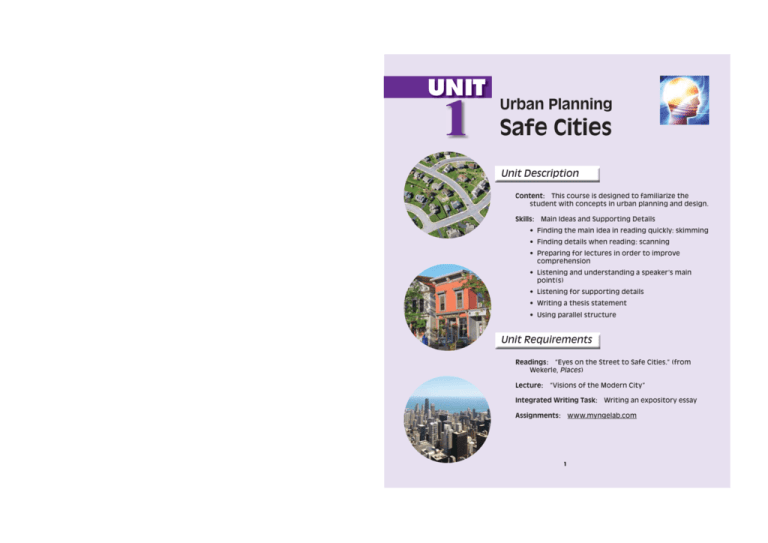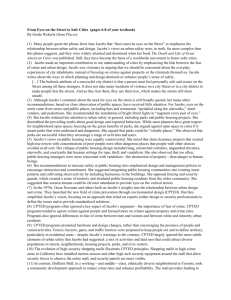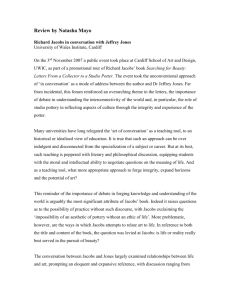View
advertisement

UNIT 1 Urban Planning Safe Cities Unit Description Content: This course is designed to familiarize the student with concepts in urban planning and design. Skills: Main Ideas and Supporting Details s &INDINGTHEMAINIDEAINREADINGQUICKLYSKIMMING s &INDINGDETAILSWHENREADINGSCANNING s 0REPARINGFORLECTURESINORDERTOIMPROVE comprehension s ,ISTENINGANDUNDERSTANDINGASPEAKERSMAIN point(s) s ,ISTENINGFORSUPPORTINGDETAILS s 7RITINGATHESISSTATEMENT s 5SINGPARALLELSTRUCTURE Unit Requirements Readings: h%YESONTHE3TREETTO3AFE#ITIESvFROM 7EKERLEPlaces) Lecture: h6ISIONSOFTHE-ODERN#ITYv Integrated Writing Task: Assignments: 7RITINGANEXPOSITORYESSAY WWWMYNGELABCOM 1 Previewing the Academic Content 1 Preview Key Words Victimization Rates per 1,000 Residents by Type of Community, 1980, 2000, 2004 More than half the world’s people live in large cities, forming a growing urban population. Almost all future population growth is expected to occur in these urban areas. With large numbers of people living closely together, personal safety is a concern. In the cities we know best, there are places where we feel safe and places where we fear for our safety. How can urban planners—the people who design cities—reduce, modify, or eliminate unsafe areas? Year 1. Label the illustrations with the key words. Property Crime metropolis n a large city rural adj relating to the countryside Violent Crime 1980 2000 2004 1980 2000 2004 U.S. Total 53 36 35 5.8 5.1 4.7 Urban Areas 61 39 37 7.0 5.6 5.1 Suburban Areas 50 41 41 3.5 4.0 3.8 Rural Areas 21 17 17 1.8 2.1 2.0 Source: Federal Bureau of Investigation in Crime in the United States—2004. (Accessed at www.fbi.gov/ucr/cius_04/documents/CIUS2004.pdf?file.) suburban adj relating to the area immediately around a city 3. Work in small groups. Discuss the questions and share your ideas with the class. urban adj relating to cities 1. Why do you think crime rates are higher in urban areas? 2. Think of areas in your city (or a large city you know) where you feel unsafe. What are some specific reasons why you do not feel safe? 3. What kinds of things might urban planners do to help lower crime rates? area area area 2. Look at the table on the next page. It compares the rates at which victims experience property and violent crime in urban, suburban, and rural areas of the United States. This rate is called the victimization rate. What can you say about the victimization rates in urban, suburban, and rural areas? In this unit, you will learn strategies for identifying main ideas and details in readings and in lectures. You will also learn how to develop main ideas and use supporting details in your writing. Previewing the Academic Skills Focus 1. Read the paragraph. Then answer the questions. If a city’s residents feel safe, then the city will be an economic, social, and cultural success. A city is different from a town in that its inhabitants are essentially strangers to each other. In an urban setting, it is most likely that individuals are surrounded by more strangers than friends. Even neighbors living closely together may be strangers. The metropolis is successful only to the extent that these strangers feel secure on the streets and in their homes. Those residents who do not feel protected will not do business, socialize, or participate in the city. A city that does not provide a safe environment for its citizens will fail in many ways. 1. What is the main point in this paragraph? Write the main idea on a separate piece of paper. Then compare your answer with a partner’s. 2. Discuss your answer to these questions with the class. r Do you agree or disagree with the main idea of this paragraph? Why? r What happens to a city if people do not feel safe there? 3. Read the last two sentences of the paragraph again. What are some specific ways in which a city might fail because its citizens don’t feel safe? 2 Unit 1 N Urban Planning Unit 1 N Safe Cities 3 Main Ideas and Details Students’ Names: The main idea is the writer or speaker’s most important idea or point. A detail is a single fact or piece of information that supports a larger idea. Detail include examples, explanations, elaborations, reasons, solutions, opinions, and exceptions. 3. Does having a bar or late-night restaurant on YOURSTREETMAKE the street safer or more dangerous? 7HY When reading, use these strategies to find the main idea of a text: s2EADTHETITLEHEADINGSANDSUBHEADINGSIFTHEREAREANY s&INDTHETOPICSENTENCEOFAPARAGRAPHORTHETHESISSTATEMENTOFANESSAY s2EADTHEFIRSTANDLASTSENTENCESOFEACHPARAGRAPH s,OOKFORREPEATEDKEYWORDSANDSYNONYMSOFKEYWORDS 4. Is it safer to have homes and stores on the same street or in separate areas of THECITY7HY 7HENYOUBECOMESKILLEDATIDENTIFYINGTHEMAINIDEAOFATEXTYOUWILLBEABLETO UNDERSTANDTHEOVERALLMEANINGQUICKLY4HISABILITYISIMPORTANTINSITUATIONSWHERE YOUHAVEALIMITEDAMOUNTOFTIMETOREADALONGTEXTORYOUNEEDTOGETAGENERAL IDEAOFWHATTHETEXTISABOUTBEFOREYOUFOCUSONTHEDETAILS Which of the strategies above did you use to find the main idea of the paragraph? What other strategies did you use? 2 Before You Read Building Academic Reading Skills In this section, you will learn strategies to identify main ideas and supporting details in textbook readings. 1. Work in groups of three and write your names at the tops of the columns. Read the questions in the first column and write your answers in your own column. Then take brief notes as you listen to your partners’ answers. Students’ Names: 1. Are large crowds of people safe or dangerous? 7HY $OYOU feel more comfortable walking down a BUSYSTREETORA deserted one? 7HY 4 5. Is it safe to have APARKONYOUR STREET7HY Unit 1 N Urban Planning Key Words 2. Based on your group’s answers, describe the safest and the most dangerous places to live. foster v to help develop over a period of time 3. Collocations are words that are frequently used together. Use a key word to make a collocation that completes each statement. internship n a short-term job that a student does to gain experience, often without pay prevailing n accepted at a particular time public housing n houses or apartments built by the government for poor people slum n an area of the city that is in very bad condition where very poor people live 1. The clearance project made the downtown safer. 2. Jane Jacobs felt it was important to a safe city movement. 3. More than half the world’s people live in large cities, forming a growing population. 4. areas can be found on the land surrounding many large cities. 5. The government built a large project downtown. 6. Visionary thinkers often suggest projects that go against the ideas of their times. Unit 1 N Safe Cities 5 Global Reading Finding the Main Idea in Reading Quickly: Skimming 7HENYOUSKIMATEXTYOUREADITSTRATEGICALLYTOUNDERSTANDITSGENERALMEANING ORMAINIDEA"ELOWARESOMESTRATEGIESYOUCANUSETOSKIMAREADING.OTICETHAT some of these strategies were listed on page 4. s2EADTHETITLEHEADINGSANDSUBHEADINGSOFATEXT s2EADTHEFIRSTANDLASTSENTENCEOFEACHPARAGRAPH s,OOKATCAPTIONSDIAGRAMSANDILLUSTRATIONS s+EEPYOUREYESMOVINGCONSISTENTLYOVERTHEPAGE s$ONTUSEADICTIONARY s$ONTSPENDTIMEREADINGTHEDETAILS Which of these strategies do you use when you want to read quickly for general comprehension? Are there other strategies that you use? What are they? 3 1. Skim paragraphs 1–6 of the text “From ‘Eyes on the Street to Safe Cities’” to find the main idea. Key Words From “Eyes on the Street to Safe Cities” corridor n a long, narrow passage with doors leading off of it sprinkle (d) v to scatter small drops of water or small pieces of something subtle adj not easy to notice unless you pay careful attention volatile adj likely to change suddenly and without warning 6 Unit 1 N Urban Planning By Gerda Wekerle (from Places) 1 Many people quote the phrase from Jane Jacobs that “there must be eyes on the street” to emphasize the relationship between urban safety and design. Jacobs’s views on urban safety were, in truth, far more complex than this phrase suggests, and they were widely attacked and dismissed when her book The Death and Life of Great American Cities was published. Still, they have become the basis of a worldwide movement to foster safer cities. 2 Jacobs made an important contribution to our understanding of cities by emphasizing the link between the fear of crime and urban design. Jacobs was visionary in arguing that we should be concerned about the everyday experiences of city inhabitants, instead of focusing on 4 crimes against property or the criminals themselves. Jacobs writes about the ways in which planning and design diminish or enhance people’s sense of safety. [ . . . ] The bedrock attribute of a successful city district is that a person must feel personally safe and secure on the street among all these strangers. It does not take many incidents of violence on a city street or in a city district to make people fear the streets. And as they fear them, they use them less, which makes the streets still more unsafe. Although Jacobs’s comment about the need for eyes on the street is still broadly quoted, her many other recommendations, based on close observation of public spaces, have received little attention. For Jacobs, eyes on the street came from stores and public places, including bars and restaurants “sprinkled along the sidewalks,” street vendors, and pedestrians. She recommended the installation of bright street lights to “augment every pair of eyes.” But Jacobs widened her attention to urban safety in general, including parks and public housing projects. She discredited the prevailing myths about good design and expected behaviors. While most planners have great respect for neighborhood open spaces focusing on the green benefits of parks, she argued against open space in 5 6 cities if it meant parks that were underused and dangerous. She argued that parks could be “volatile places.” She observed that parks are successful when they encourage a range of activities and users. Jacobs’s views on public housing were equally controversial. She noted that slum clearance projects that created high-rise towers with concentrations of poor people were often dangerous places that people with other choices avoided at all cost. Her critique of public housing design included long, unwatched corridors, unguarded elevators, stairwells, and courtyards that became settings for rape, theft, and vandalism. She also observed that too often, public housing managers were more concerned with vandalism—the destruction of property—than danger to human beings. Her recommendations to increase safety at public housing sites emphasized design and management policies to encourage interaction and commitment. She suggested integrating public housing communities into existing street patterns and cultivating street activity by including businesses in the buildings. She opposed fencing and security guards, which created a sense of territory and insulated public housing residents from the wider community. She suggested that women tenants could be elevator attendants to provide eyes on the vertical streets. (continued on next page) 2. Circle the choice that best represents the main idea of paragraphs 1–6. a. Jacobs wrote a book called The Death and Life of Great American Cities. b. Jacobs examined the relationship between safety and urban planning. c. Jacobs felt that including businesses in public housing projects would improve safety. Unit 1 N Safe Cities 7 5. Now skim paragraphs 7–12 to find the main idea. Focused Reading Finding Details When Reading: Scanning 7 8 9 In the 1970s, Oscar Newman and others built on Jacobs’s insights into the relationship between urban design and crime. They launched the new field of crime prevention through environmental design (CPTED). But they simplified Jacobs’s vision, focusing on an approach that relied on experts (either design or security professionals) to define the issues and to provide standardized solutions. CPTED programs often ignored a key aspect of Jacobs’s argument—the importance of fear of crime. CPTED programs tended to ignore crimes against people and focused more on crimes against property and crime rates. Programs also ignored differences in fear of crime between men and women and between white and minority urban residents. CPTED programs promoted hardware and design changes, rather than encouraging the presence of people and varied activities. Fences, buzzers, gates, and traffic barriers were proposed to keep people out and to define territory, particularly in residential areas—despite Jacobs’s warnings to the contrary. CPTED largely ignored the more subtle elements of urban safety that Jacobs had suggested: a mix of activities and land uses that could attract diverse populations to streets, neighborhoods, housing projects, parks, and civic centers. 10 11 12 The evolution of high-security shopping malls illustrates CPTED principles. Shopping malls in high-crime areas in California have installed motion sensors and other high-tech security equipment around the mall that allow security forces to observe the entire mall, and security patrols are more visible. In contrast, Dufferin Mall, in a workingand middle-class, ethnically diverse neighborhood in Toronto, took a community development approach to reduce crime rates and enhance profitability. The mall provides funding to youth theater, basketball, and soccer organizations; merchants participate in a youth internship program; it provides rent-free space for youth services, a teen drop-in center, a program for high-school dropouts, and a clothing exchange. As Jacobs suggested, these have brought a range of activities and users into the mall and reduced crime rates. Jacobs wrote about her experience of daily life in the city and urged planners to pay attention to how ordinary people actually use urban space. From her experience as a wife, mother, and resident of Greenwich Village in New York City, she arrived at a more human vision of the city than the experts of the day did. Her concern about urban safety was visionary, and her manner of looking at the city still offers a critical viewpoint for evaluating crime prevention and community safety strategies today. 3CANNINGISREADINGSTRATEGICALLYTOFINDTHEANSWERSTOSPECIFICQUESTIONS)TCANBE ESPECIALLYVALUABLEWHENYOUNEEDTOANSWERASETOFQUESTIONSINASHORTAMOUNTOF TIME(EREARESOMESTRATEGIESYOUCANUSETOSCANREADINGSFORANSWERS ! &INDAKEYWORDINTHEQUESTIONANDSEARCHFORTHEKEYWORDORASYNONYMOF it, in the text. " ,OOKFORCAPITALIZEDLETTERSIFYOUARELOOKINGFORANANSWERTOAwhere or who question. # 2EADQUOTES!UTHORSUSUALLYQUOTEONLYTHEMOSTIMPORTANTINFORMATIONFROM another author. $ ,OOKFORNUMBERSIFYOUARELOOKINGFORANANSWERTOANUMERICALQUESTION E. Read the first and last sentence of each paragraph to find the paragraph in WHICHYOUWILLMOSTLIKELYFINDTHEANSWER & ,OOKFORKEYTRANSITIONWORDSSUCHASin contrast, however, and therefore. These indicate that a new point of view will be introduced. 1. Scan the entire text on pages 6 to 8 and write answers to the questions. Write the letter of the strategy you used and a brief description of the strategy. 1. Who is the author who wrote The Death and Life of Great American Cities? Answer: Jane Jacobs Strategy: B—Look for capitalized letters to answer a “who” question 2. According to Jacobs, what makes the streets less safe? Answer: Strategy: 3. What did Jacobs recommend to increase the eyes on the streets? Answer: Strategy: 4. What were Jacobs’s views on public residential projects? Answer: Strategy: 6. Circle the choice that best represents the main idea of paragraphs 7–12. a. The CPTED movement was built on Jacobs’s views of urban planning to encourage urban safety. b. The CPTED movement misinterpreted Jacobs’s views of how to achieve urban safety. c. The Dufferin Mall is an example of a CPTED project. 7. Now share your answers with a partner‘s and talk about the strategies you used to find the main ideas of the text. Which strategies were most useful for you? Why? 8 Unit 1 N Urban Planning 5. When did Oscar Newman and others create the crime prevention through environmental design (CPTED) movement? Answer: Strategy: 6. How did CPTED simplify Jacobs’s vision? Answer: Strategy: Unit 1 N Safe Cities 9








